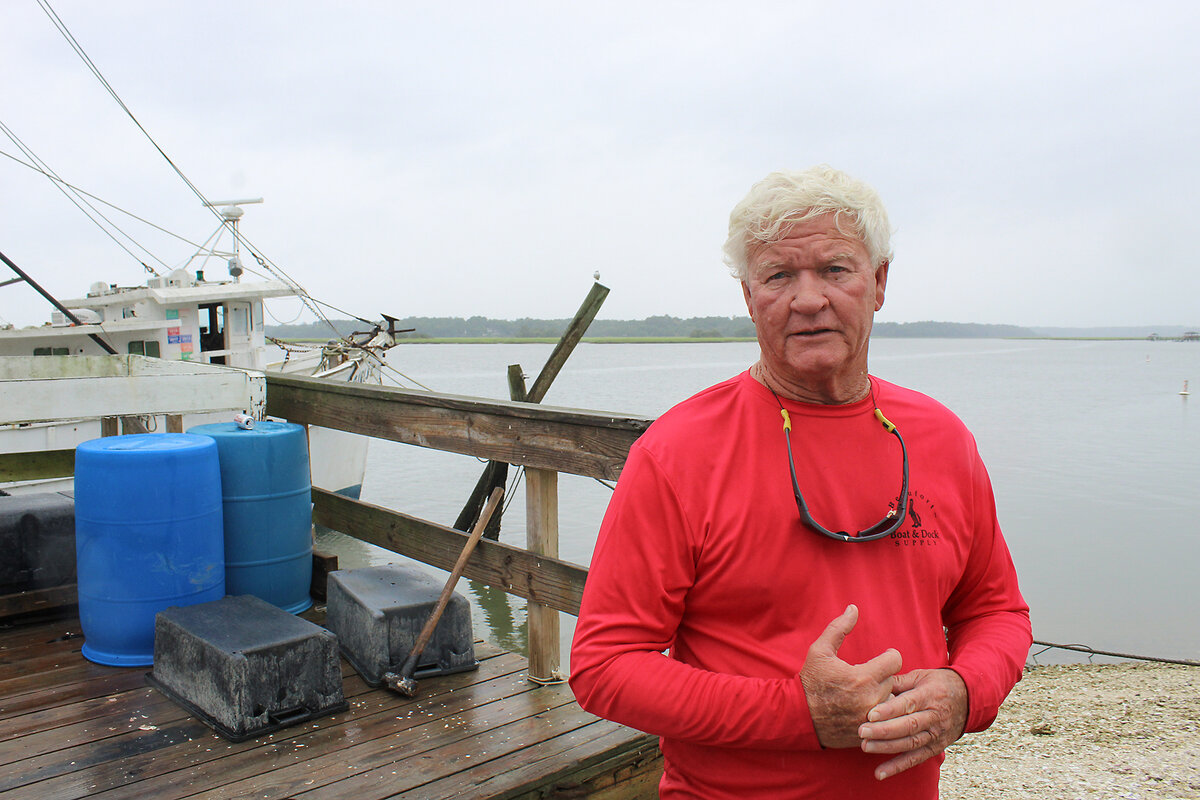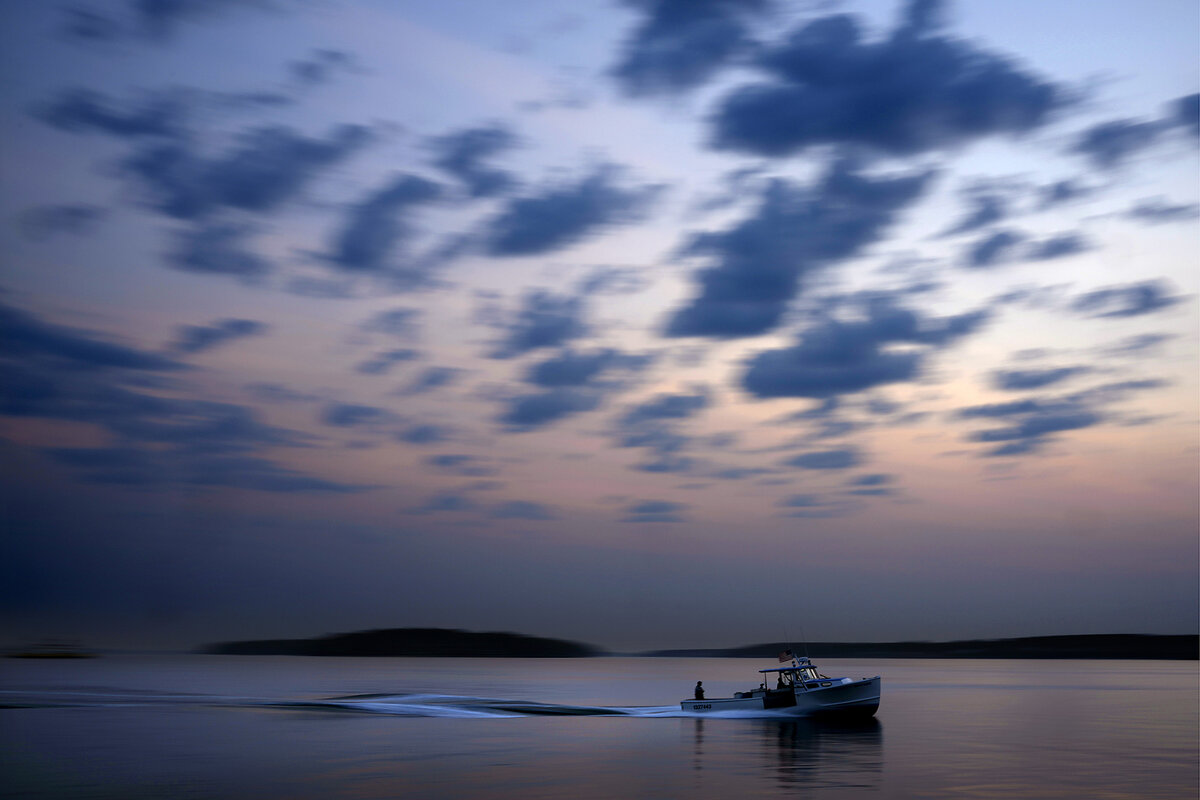Can US seafood industry revive? Mayor and fishmonger Larry Toomer has a recipe.
Loading...
| BLUFFTON, S.C.
Day after day, the piles of shucked shells slowly become tiny mountains behind Bluffton Oyster Co., a gray clapboard shack where a crew of fast hands pries away at oysters and crabs, a bounty bound for local markets and eateries.
In many ways, Bluffton’s May River waterfront here is a throwback to bygone days when local fishermen and fish houses provided most of America’s seafood. Now, like a pearl inside an oyster, the smooth, shiny prospect of renewal – of sustainability and food self-sufficiency – awaits discovery.
Helming the charge for renewal is Bluffton, South Carolina’s new Mayor Larry Toomer, the oyster shack’s owner, who sees as his mandate preserving and linking a working waterfront to the region’s growing suburbs. Why does this gambit matter beyond America’s Low Country? Because the seafood unloaded here plays a crucial role in the nation’s health and security, Mayor Toomer says.
Why We Wrote This
A story focused onAmericans are eating more seafood. But higher consumption has boosted seafood imports as domestic fisheries struggle. Change may require reinvestment in waterfronts and new views of what is edible.
“I used to think nuclear war was our biggest threat,” he says. “Now I think it’s our ability to feed ourselves if something goes wrong.”
Aside from coastal recreational opportunities, Americans have become largely disconnected from the ocean’s riches. In fact, the United States is the world’s second-biggest commercial fishery. But the White House National Strategy on Hunger, Nutrition, and Health doesn’t even mention seafood as an asset.
Experts say that “blue food” isn’t a part of a broader conversation about America’s food security or food system transformation largely because of a common public perception that fish, oysters, and shrimp are a luxury, not a necessity. At the same time, the gap between fish catchers and fish eaters – no more “my neighbor is a shrimper” – has widened.
The challenge, says Mayor Toomer, is a sense among local fishers that “we’ve basically been left to die” even as seafood consumption has risen from 12 pounds to 20 pounds per capita in the past 30 years.
Independence “not beyond reach”
While the U.S. has traditionally been one of the world’s largest food producers – particularly of corn, soybeans, and wheat – it has become increasingly reliant on foreign countries for seafood, now considered a healthy diet staple. Despite its capacity to rely solely on the seafood it produces, the nation exports the majority of it and imports 80% to 90% of the seafood Americans consume.
The U.S. is still a global fishing superpower, but with more people eating fish as part of a regular diet, America’s fishers now produce an amount equal to only 76% of the nation’s seafood demand. In 1979, New England reached 179% self-sufficiency; as of 2021, the region is only 36% self-sufficient, according to a study published in Nature magazine this summer.
Still, researchers at the University of Maine in Orono recently found that U.S. seafood independence is “not beyond reach.”
Change will require investment in domestic processing and working waterfronts, researchers say, as well as a more expansive view by Americans of what ocean fare is edible.
At the same time, there is growing awareness that U.S. seas can be sustainably harvested at higher levels than they currently are, says Ray Hilborn, a fisheries biologist at the University of Washington in Seattle. Today, the U.S. fishing fleet captures only 70% of the sustainable catch. Norway and Iceland? Nearly 100%.
“U.S. regulatory agencies have adopted very precautionary management,” says Dr. Hilborn. “The irony, then, is that we end up importing fish from countries that have few environmental protections.”
Rough-looking characters – or caretakers?
Most important, “if we want to achieve seafood security, there has to be a consumer reference shift,” says Tolulope Oyikeke, a researcher at the University of Maine.
When one of Pete Halmay’s friends entered the words “commercial fisherman” into an AI program, the computer spit out images that both amused and dismayed Mr. Halmay, who has been a sea urchin diver for 50 years.
The result was “some rough-looking characters,” he says. “And I thought, ‘Wow, here’s where we start from. This is what people think.’”
His home port of San Diego shares the same story. Once home to a massive tuna boat fleet, the fishery collapsed. Boats dispersed. Yet small-boat fishermen still work the waters for a variety of catch, from mackerel to yellowfin tuna.
Making a living had become difficult, given consolidation of processor power, vanishing dock space, and fishery policies that created private fishing rights for popular species – including wreckfish, quahogs, and tanner crabs – that are bought and traded in “catch shares.”
A decade ago, Mr. Halmay had an idea to fight back. He set up a dockside market where fishermen sold their catch right off their boats. The legislature had to rewrite law to allow fishers to display and cut fish on the dock.
A decade later, hundreds of people visit San Diego’s Tuna Harbor Dockside Market each Saturday, buying yellowfin tuna for as little as $5 a pound, a quarter of the price in grocery stores. In July, the dockside market introduced a new auction to move even larger amounts of fish.
The key has been giving consumers the chance to connect the catch to the fisher.
“If it’s thrown into a commodity, everything is the same, so why should I pay special attention to it?” says Mr. Halmay. “But if you make fishermen responsible for it, they take better care of it.”
Leadership on local waterfronts
Karen Bell is the scion of a Florida fishing family that spans three generations. Her hometown fishing village, Cortez, has seen ups and downs, but its survival against global and domestic forces, Ms. Bell says, is largely because of its resilient fishers.
“It’s an environment where people seem to thrive and where your focus is more on just being happy, loving what you do, and doing it,” says Ms. Bell, who owns A.P. Bell Fish Co.
As part of that spirit, she says, a local fishers’ consortium recently bought a piece of marshland at the edge of the village to protect it from development – and showcase its value to the fishery.
Still, she has to balance nostalgia with reality. A number of her boats are stuck at dock, thanks to tight snapper quotas. “It’s hard to even think about getting rid of ‘the girls,’” as she calls the boats, all named after women in her family.
But when asked if the U.S. can supply all its own fish, she answers as a seafood self-reliance skeptic. “I don’t know if it’s feasible,” says Ms. Bell. “Today you would need a pile of money to get into this. But the tide turns.”
In Alaska, regulators are fighting to reserve catch shares for younger fishers and community groups. In Point Judith, Rhode Island, the Town Dock is a major domestic supplier of calamari. In Tybee Island, Georgia, the Tybee Oyster Co. opened the state’s first floating oyster farm, the result of a legislative change. Briny “salt bomb” oysters are a hit with locals and visitors.
And here in Bluffton, Mayor Toomer and the city council are focused on waterfront improvements to not only preserve but also to showcase what he calls “this incredible, sustainable treasure.”
To move toward sustainability and food self-reliance, “One thing that’s absolutely important is leadership,” says Mr. Halmay, the sea urchin diver. “If your little area doesn’t have a leader willing to stick their neck out, it’s not going to work.”








